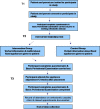Influence of supplemental written information on adolescent anxiety, motivation and compliance in early orthodontic treatment
- PMID: 19905859
- PMCID: PMC8973242
- DOI: 10.2319/042809-138.1
Influence of supplemental written information on adolescent anxiety, motivation and compliance in early orthodontic treatment
Abstract
Objectives: To test the null hypotheses that supplementation of verbal information with written information when obtaining consent to orthodontic treatment has no effect on (1) anxiety, motivation and apprehension related to treatment and (2) compliance in the early stages of fixed appliance therapy.
Materials and methods: Seventy-six adolescents who were due to start fixed appliance therapy were randomly allocated to receive verbal information only or verbal and written information before orthodontic treatment. Participants' anxiety, motivation, and apprehension were assessed using a questionnaire that was completed prior to meeting the orthodontic clinician (T1), following consent to treatment (T2), and after 12 weeks of treatment (T3). Appointment attendance, appliance breakages, and periodontal scores were used as measures of patient compliance.
Results: Sixty participants completed the study. At T2 there was no change in anxiety scores for either group (P = .412); however, increased motivation was detected in the group that had been given both written and verbal information (P = .049). At T3 both groups demonstrated similar reductions in anxiety (P = .311) and apprehension (P = .790) and similar levels of motivation (P = .756). A reduction in periodontal scores (P = .065), better appointment attendance (P = .732), and fewer breakages (P = .525) were reported in the group that was given additional information, although these changes were not statistically significant.
Conclusions: Supplementation of verbal information with written information resulted in improved motivation for orthodontic treatment but had no statistically significant effect on anxiety, apprehension, or patient compliance.
Figures
References
-
- Sari Z, Uysal T, Karaman A. L, Sargin N, Ure O. Does orthodontic treatment affect patients' and parents anxiety levels? Eur J Orthod. 2005;27:155–159. - PubMed
-
- Thickett E, Newton J. T. Using written material to support recall of orthodontic information: a comparison of three methods. Angle Orthod. 2006;76:243–250. - PubMed
-
- Bos A, Hoogstraten J, Prahl-Andersen B. Towards a comprehensive model for the study of compliance in orthodontics. Eur J Orthod. 2005;27(3):296–301. - PubMed
-
- Patel J. H, Moles D. R, Cunningham S. J. Factors affecting information retention in orthodontic patients. Am J Orthod Dentofacial Orthop. 2008;133:61–67. - PubMed
-
- Lees A, Rock W. P. A comparison between written, verbal, and videotape oral hygiene instruction for patients with fixed appliances. J Orthod. 2000;27:323–327. - PubMed
Publication types
MeSH terms
LinkOut - more resources
Full Text Sources
Medical





